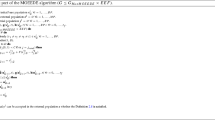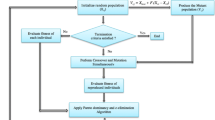Abstract
The redundant humanoid manipulator has characteristics of multiple degrees of freedom and complex joint structure, and it is not easy to obtain its inverse kinematics solution. The inverse kinematics problem of a humanoid manipulator can be formulated as an equivalent minimization problem, and thus it can be solved using some numerical optimization methods. Biogeography-based optimization (BBO) is a new biogeography inspired optimization algorithm, and it can be adopted to solve the inverse kinematics problem of a humanoid manipulator. The standard BBO algorithm that uses traditional migration and mutation operators suffers from slow convergence and prematurity. A hybrid biogeography-based optimization (HBBO) algorithm, which is based on BBO and differential evolution (DE), is presented. In this hybrid algorithm, new habitats in the ecosystem are produced through a hybrid migration operator, that is, the BBO migration strategy and DE/best/1/bin differential strategy, to alleviate slow convergence at the later evolution stage of the algorithm. In addition, a Gaussian mutation operator is adopted to enhance the exploration ability and improve the diversity of the population. Based on these, an 8-DOF (degree of freedom) redundant humanoid manipulator is employed as an example. The end-effector error (position and orientation) and the ‘away limitation level’ value of the 8-DOF humanoid manipulator constitute the fitness function of HBBO. The proposed HBBO algorithm has been used to solve the inverse kinematics problem of the 8-DOF redundant humanoid manipulator. Numerical simulation results demonstrate the effectiveness of this method.
Similar content being viewed by others
References
Chen, D.J., Gong, Q.W., Qiao, H., et al., 2012. Multiobjective generation dispatching for wind power integrated system adopting improved biogeography-based optimization algorithm. Proc. CSEE, 32(31):150–158 (in Chinese).
Chen, P., Liu, L., Yu, F., et al., 2012. A geometrical method for inverse kinematics of a kind of humanoid manipulator. Robot, 34(2):211–216 (in Chinese). [doi:10.3724/SP.J.1218.2012.00211]
Costa e Silva, M.A., Coelho, L.D.S., Lebensztajn, L., 2012. Multiobjective biogeography-based optimization based on predator-prey approach. IEEE Trans. Magn., 48(2): 951–954. [doi:10.1109/TMAG.2011.2174205]
Feller, W., 1971. An Introduction to Probability Theory and Its Applications. Wiley, New York, USA.
Goldberg, D.E., 1989. Genetic Algorithms in Search, Optimization, and Machine Learning. Addison-Wesley Professional, London, UK.
Gong, W.Y., Cai, Z.H., Ling, C.X., et al., 2010. A realcoded biogeography-based optimization with mutation. Appl. Math. Comput., 216(9):2749–2758. [doi:10.1016/ai]j.amc.2010.03.123]
Kajita, S.J., 2005. Humanoid Robots. Guan, Y., translator, 2007. Tsinghua University Press, Beijing, China (in Chinese).
Kennedy, J., Eberhart, R., 1995. Particle swarm optimization. Proc. IEEE Int. Conf. on Neural Networks, p.1942-1948. [doi:10.1109/ICNN.1995.488968]
Köker, R., Öz, C., Çakar, T., et al., 2004. A study of neural network based inverse kinematics solution for a threejoint robot. Robot. Auton. Syst., 49(3-4):227–234. [doi:10.1016/j.robot.2004.09.010]
Ma, B.J., Fang, Y.C., Zhang, X.B., 2007. Inverse kinematics analysis for a mobile manipulator with redundant DOFs. Proc. 26th Chinese Control Conf., p.118-122. [doi:10.1109/CHICC.2006.4346874]
Ma, H.P., Simon, D., 2011. Blended biogeography-based optimization for constrained optimization. Eng. Appl. Artif. Intell., 24(3):517–525. [doi:10.1016/j.engappai.2010.08.005]
Nearchou, A.C., 1998. Solving the inverse kinematics problem of redundant robots operating in complex environments via a modified genetic algorithm. Mech. Mach. Theory, 33(3):273–292. [doi:10.1016/S0094-114X(97)00034-7]
Simon, D., 2008. Biogeography-based optimization. IEEE Trans. Evol. Comput., 12(6):702–713. [doi:10.1109/TEVC.2008.919004]
Storn, R., Price, K., 1997. Differential evolution—a simple and efficient heuristic for global optimization over continuous spaces. J. Global Optim., 11(4):341–359. [doi:10.1023/A:1008202821328]
Tian, Y., Chen, X.P., Jia, D.Y., et al., 2011. Design and kinematic analysis of a light weight and high stiffness manipulator for humanoid robots. Robot, 33(3):332–339 (in Chinese). [doi:10.3724/SP.J.1218.2011.00332]
Wang, L., Chen, C.C., 1991. A combined optimization method for solving the inverse kinematics problems of mechanical manipulators. IEEE Trans. Robot. Autom., 7(4):489–499. [doi:10.1109/70.86079]
Wang, L., Xu, Y., 2011. An effective hybrid biogeographybased optimization algorithm for parameter estimation of chaotic systems. Expert Syst. Appl., 38(12):15103–15109. [doi:10.1016/j.eswa.2011.05.011]
Yang, G.P., Liu, S.Y., Zhang, J.K., et al., 2013. Control and synchronization of chaotic systems by an improved biogeography-based optimization algorithm. Appl. Intell., 39(1):132–143. [doi:10.1007/s10489-012-0398-0]
Yin, F., Wang, Y.N., Wei, S.N., 2011. Inverse kinematic solution for robot manipulator based on electromagnetismlike and modified DFP algorithms. Acta Autom. Sin., 37(1):74–82. [doi:10.3724/SP.J.1004.2011.00074]
Zhao, J., Wang, W.Z., Cai, H.G., 2006. Generation of closedform inverse kinematics for reconfigurable robots. Chin. J. Mech. Eng., 42(8):210–214 (in Chinese). [doi:10.3901/JME.2006.08.210]
Author information
Authors and Affiliations
Corresponding author
Additional information
Project supported by the National Natural Science Foundation of China (No. 61273340) and the China Postdoctoral Science Foundation (No. 2013M541721)
ORCID: Zi-wu REN, http://orcid.org/0000-0002-3774-2273
Rights and permissions
About this article
Cite this article
Ren, Zw., Wang, Zh. & Sun, Ln. A hybrid biogeography-based optimization method for the inverse kinematics problem of an 8-DOF redundant humanoid manipulator. Frontiers Inf Technol Electronic Eng 16, 607–616 (2015). https://doi.org/10.1631/FITEE.14a0335
Received:
Accepted:
Published:
Issue Date:
DOI: https://doi.org/10.1631/FITEE.14a0335
Keywords
- Inverse kinematics problem
- 8-DOF humanoid manipulator
- Biogeography-based optimization (BBO)
- Differential evolution (DE)




